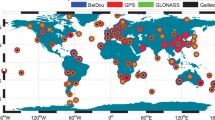Abstract
The world of satellite navigation is experiencing an era of expansion, as the GNSS community is growing. Besides the two already operational systems, the United States of America’s GPS and Russia’s GLONASS, two additional constellations are currently under development and near to be completed: the Chinese BeiDou and the European Galileo. Within 2020, four systems are then expected to be fully operational and will offer immense possibilities to improve navigation performance in terms of availability, continuity, reliability and accuracy. This chapter focuses on current and future GNSS, giving an introduction to each system and pointing out advantages and challenges of the multi-constellation scenario.
Access this chapter
Tax calculation will be finalised at checkout
Purchases are for personal use only
Similar content being viewed by others
References
Navstar Global Positioning System Interface Specification is-GPS-200, Revision D. Technical report, GPS Joint Program Office (2006)
E.D. Kaplan et al., Understanding GPS - Principles and Applications, 2nd edn. (Artech House, Boston, 2006)
Navipedia, GPS Future and Evolutions. Accessed 19 Dec 2016. http://www.navipedia.net/index.php/GPS_Future_and_Evolutions
W.M. Mularie, World geodetic system 1984–its definition and relationships with local geodetic systems. Technical report (2000)
European Union 2015, Galileo open service signal in space interface control document. Technical report, 1.2. Accessed 24 May 2016
D. Minh Truong, T. Hai Ta, Development of real multi-GNSS positioning solutions and performance analyses, in 2013 International Conference on Advanced Technologies for Communications (ATC) (IEEE, Ho Chi Minh City, 2013), pp. 158–163
S. Soderholm et al., A multi-GNSS software-defined receiver: design, implementation, and performance benefits. Ann. Telecommun. 71 (7), 399–410 (2016)
H. Bhuiyan et al., Performance analysis of a multi-GNSS receiver in the presence of a commercial jammer, in 2015 International Association of Institutes of Navigation World Congress (IAIN) (IEEE, Prague, 2015), pp. 1–6
N.G. Ferrara, E.S. Lohan, J. Nurmi, Multi-GNSS analysis based on full constellations simulated data, in 2016 International Conference on Localization and GNSS (ICL-GNSS) (Barcelona, 2016)
M. Sahmoudi, R. Landry Jr., F. Gagnon, Robust mitigation of multipath and ionospheric delays in multi-GNSS real-time kinematic (RTK) receivers, in IEEE/SP 15th Workshop on Statistical Signal Processing, SSP’09 (IEEE, Cardiff, 2009), pp. 149–152
K. Borre et al., A Software-Defined GPS and Galileo Receiver: A Single-Frequency Approach (Springer, Dordrecht, 2007)
GMV, Navipedia, Integrity. Accessed 19 Dec 2016. http://www.navipedia.net/index.php/Integrity
A. Druzhin, A. Tyulyakov, A. Pokhaznikov, Broadcasting system time scales offsets in navigation messages. Assessment of feasibility. Technical report (2013)
China Satellite Navigation Office, BeiDou navigation satellite system signal in space interface control document - open service signal. Technical report, 2.0 (2013)
Russian Institute of Space Device Engineering, GLONASS interface control document. Technical report, 5 Jan 2008
Working Group D International Committee on GNSS, Report of working group: reference frames, timing and applications. Technical report (2010)
Acknowledgements
This work was financially supported by EU FP7 Marie Curie Initial Training Network MULTI-POS (Multi-technology Positioning Professionals) under grant nr. 316528.
Author information
Authors and Affiliations
Corresponding author
Editor information
Editors and Affiliations
Rights and permissions
Copyright information
© 2017 Springer International Publishing AG
About this chapter
Cite this chapter
Ferrara, N.G., Daniel, O., Figueiredo e Silva, P., Nurmi, J., Lohan, ES. (2017). Multi-GNSS: Facts and Issues. In: Nurmi, J., Lohan, ES., Wymeersch, H., Seco-Granados, G., Nykänen, O. (eds) Multi-Technology Positioning. Springer, Cham. https://doi.org/10.1007/978-3-319-50427-8_6
Download citation
DOI: https://doi.org/10.1007/978-3-319-50427-8_6
Published:
Publisher Name: Springer, Cham
Print ISBN: 978-3-319-50426-1
Online ISBN: 978-3-319-50427-8
eBook Packages: EngineeringEngineering (R0)




